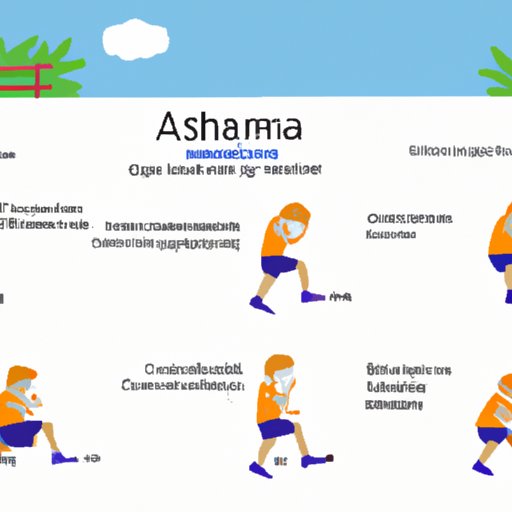Introduction
Exercise-induced asthma (EIA) is a type of asthma that is triggered by physical activity and can cause difficulty breathing during exercise or physical exertion. It is also sometimes known as exercise-induced bronchoconstriction (EIB). EIA is different from other types of asthma in that it is only triggered by physical activity and does not occur at other times.
Definition of Exercise-Induced Asthma
Exercise-induced asthma is defined as a narrowing of the airways that occurs due to physical activity. This narrowing can make it difficult for air to flow through the lungs, resulting in shortness of breath, coughing, wheezing, and chest tightness. The symptoms typically start within five to 10 minutes after exercise begins, but they can also start during or even up to an hour after exercise has ended.
Overview of Symptoms and Causes
The most common symptom of EIA is shortness of breath. Other symptoms may include coughing, wheezing, chest tightness, and fatigue. These symptoms are usually worse when exercising in cold and dry environments. Some people may also experience symptoms such as headaches, dizziness, and nausea.
The cause of EIA is not completely understood, but it is thought to be caused by a combination of factors. These include a person’s physical fitness level, the type of exercise being performed, the temperature and humidity of the environment, and the amount of pollen or other allergens in the air.
Understanding How to Manage Exercise-Induced Asthma
The first step in managing EIA is to identify and avoid triggers. Common triggers include cold air, dry air, and allergens such as pollen and dust. It is also important to warm up before exercise and cool down afterwards.
Risk Factors
There are certain risk factors that can increase a person’s likelihood of developing EIA. These include having a family history of asthma, allergies, or respiratory illnesses; living in areas with high levels of air pollution; and participating in sports or activities that involve intense or prolonged exertion.
Treatments
Treatment for EIA typically involves avoiding triggers, using medications such as inhalers, and taking part in breathing exercises. Inhalers can help open up the airways and allow more air to enter the lungs. Breathing exercises can help strengthen the muscles used for breathing, making it easier to take deep breaths.
Prevention
In addition to avoiding triggers and using medication, there are several steps that can be taken to prevent EIA. These include wearing a face mask during exercise, staying hydrated, and wearing clothes that are loose-fitting and made of breathable fabrics. It is also important to warm up and cool down properly before and after exercise.
Comparing Exercise-Induced Asthma to Other Types of Asthma
EIA is different from other types of asthma in that it is only triggered by physical activity. Unlike other types of asthma, which can be triggered by environmental factors such as pollen or air pollution, EIA is not affected by these things. However, both types of asthma can cause similar symptoms such as coughing, wheezing, and chest tightness.
Investigating the Impact of Exercise-Induced Asthma on Performance
EIA can have a negative impact on athletic performance. Symptoms such as shortness of breath and chest tightness can make it difficult to perform at peak levels. Additionally, athletes with EIA may be more prone to fatigue and injury due to their inability to get enough oxygen during exercise.
Effects on Athletic Performance
The effects of EIA on athletic performance can vary depending on the severity of the condition. Those with mild EIA may only experience minor decreases in performance, while those with severe EIA may experience significant decreases in performance. Additionally, athletes with EIA may be more prone to fatigue and injury due to their inability to get enough oxygen during exercise.
Strategies for Improvement
There are several strategies that can be used to improve athletic performance in those with EIA. These include avoiding triggers, using medications such as inhalers, and taking part in breathing exercises. Additionally, athletes should focus on warming up and cooling down properly, staying hydrated, and wearing clothing that is loose-fitting and made of breathable fabrics.
Conclusion
Exercise-induced asthma is a respiratory condition that is triggered by physical activity and can cause difficulty breathing during exercise. It is different from other types of asthma in that it is only triggered by physical activity and is not affected by environmental factors. Additionally, EIA can have a negative impact on athletic performance, leading to decreased performance and increased risk of fatigue and injury. However, there are several strategies that can be used to manage EIA and improve athletic performance, including avoiding triggers, using medications, and taking part in breathing exercises.
In conclusion, exercise-induced asthma can be a challenging condition to live with, but with proper management, those affected can still lead active and healthy lives.
(Note: Is this article not meeting your expectations? Do you have knowledge or insights to share? Unlock new opportunities and expand your reach by joining our authors team. Click Registration to join us and share your expertise with our readers.)
